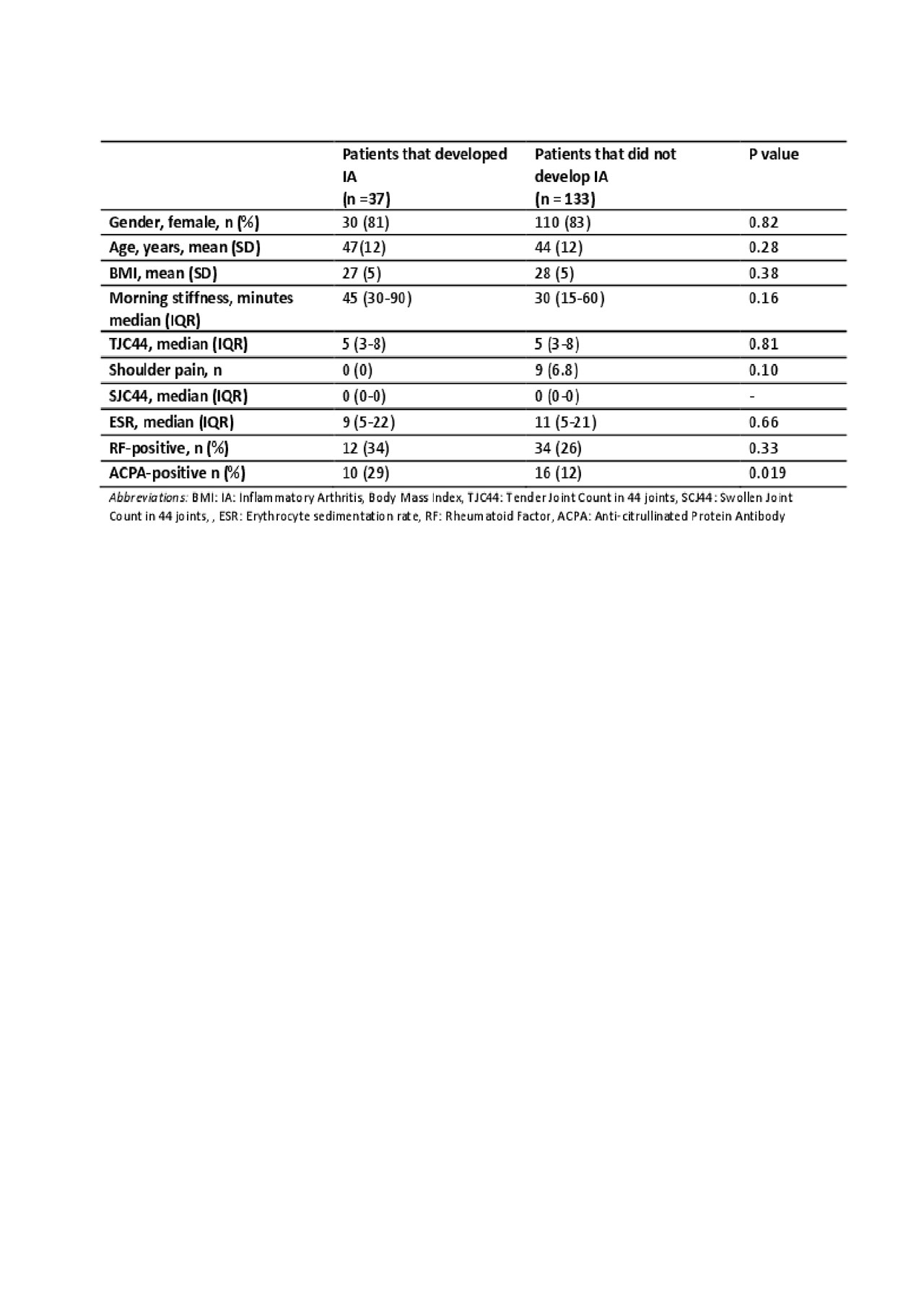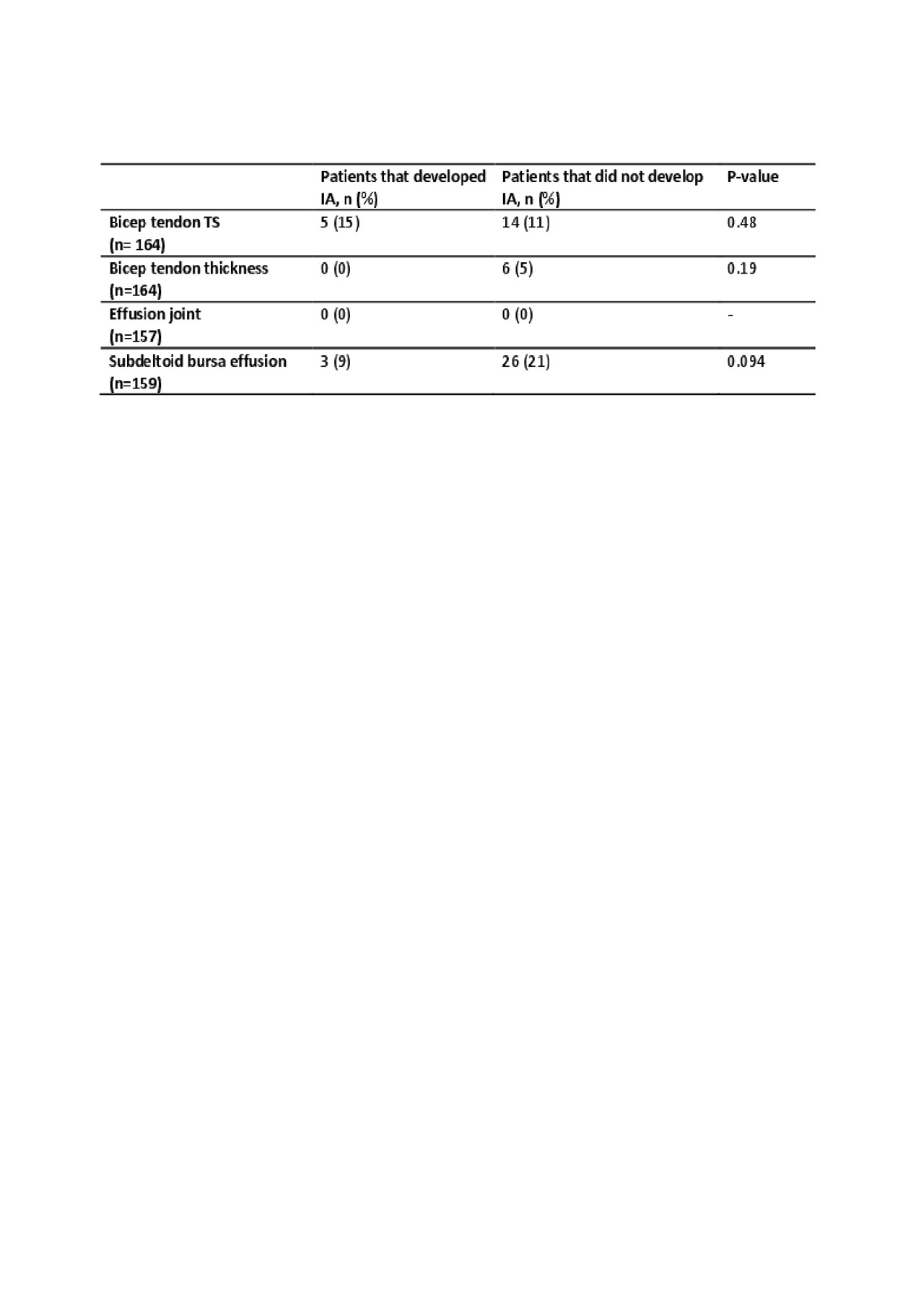Session Information
Session Type: Poster Session (Sunday)
Session Time: 9:00AM-11:00AM
Background/Purpose: Background: Multiple studies have demonstrated that shoulder involvement is frequent in Rheumatoid Arthritis (RA). Previous research also showed that a swollen shoulder joint has a similar predictive value as small joint involvement for developing RA in patients with undifferentiated arthritis (UA). The phase of clinically suspect arthralgia (CSA) precedes the phase of clinically apparent arthritis; in this phase subclinical tenosynovitis of the hands, visualized with MRI or US, is predictive for developing RA. Given the similarities in predictive values between the shoulder and small joints in UA, and the predictive value of tenosynovitis in CSA, we hypothesized that subclinical tenosynovitis of the shoulder is a predictor for RA development in CSA. Within the shoulder the biceps tendon is the most obvious to investigate, because it passes though the shoulder joint and is covered with a synovial sheet. Objective: Therefore, the aim of this study is to examine the predictive value of tenosynovitis of the bicep tendon by ultrasound (US) on developing inflammatory arthritis (IA) in CSA patients.
Methods: Methods: The SONAR (Sonographic evaluation of hands, shoulders and feet in patients presenting with inflammatory arthralgia to identify subclinical arthritis)-study is a multi-center observational cohort study in which patients were followed on the development of clinically apparent inflammatory arthritis (IA). Visits were done at baseline and every 6 months thereafter. At baseline a US of both shoulders was made. 1-year follow-up data were used. IA was defined as having an arthritis verified by the treating physician. We investigated whether there was a relation between the development of IA and the presence of (1) biceps tenosynovitis (TS); (2) a thickened biceps tendon without power Doppler; (3) joint effusion and (4) subdeltoid bursa effusion on US. Reference values for tendon thickness and effusion of the bursa were determined according to Schmidt et al.(1)
Results: Results: A total of 170 patients were included and underwent bilateral US of the shoulder joint. Shoulder symptoms were infrequent (Table 1). After one year 37 patients developed IA (22%). ACPA positivity was associated with the development of IA (Table 1). As presented in Table 2, US abnormalities of the shoulder were infrequent and not associated with IA-development. In particular biceps tenosynovitis was not increased in the patients that developed IA.
Conclusion: Conclusion: Subclinical tenosynovitis of the shoulder is not an early feature of RA in patients with CSA.
Reference:
- Schmidt WA, Schmidt H, et al. Standard reference values for musculoskeletal ultrasonography. Ann Rheum Dis. 2004 Aug;63(8):988-94.
To cite this abstract in AMA style:
Rogier C, de Jong P, van der Helm-van Mil A. Is Shoulder Involvement an Early Feature of Rheumatoid Arthritis in Clinically Suspect Arthralgia? A Longitudinal Ultrasound Study [abstract]. Arthritis Rheumatol. 2019; 71 (suppl 10). https://acrabstracts.org/abstract/is-shoulder-involvement-an-early-feature-of-rheumatoid-arthritis-in-clinically-suspect-arthralgia-a-longitudinal-ultrasound-study/. Accessed .« Back to 2019 ACR/ARP Annual Meeting
ACR Meeting Abstracts - https://acrabstracts.org/abstract/is-shoulder-involvement-an-early-feature-of-rheumatoid-arthritis-in-clinically-suspect-arthralgia-a-longitudinal-ultrasound-study/


